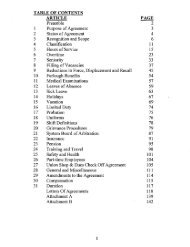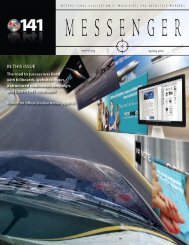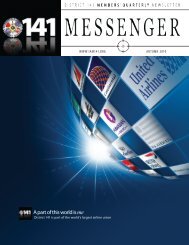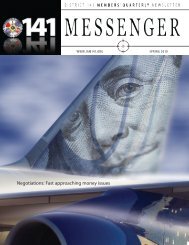One Airline One Union 55,000 Members - District 141
One Airline One Union 55,000 Members - District 141
One Airline One Union 55,000 Members - District 141
Create successful ePaper yourself
Turn your PDF publications into a flip-book with our unique Google optimized e-Paper software.
Equal justice<br />
Unless you’re a union leader<br />
Prior to World War I, union leaders<br />
were declared enemies of the state<br />
by the United States Supreme Court.<br />
Many were jailed during the govern-<br />
ment campaign of harassment.<br />
Some of the same leaders were<br />
fighting for racial equality.<br />
LABOR HISTORY<br />
Early labor efforts foster<br />
racial equality<br />
Even the Labor Movement was not immune to the rampant<br />
racial discrimination prevalent in the United States in the<br />
early part of the 20th Century.<br />
Just as with most institutions in society, many — but not<br />
all — unions were parties to segregation and racial inequality.<br />
<strong>One</strong> significant exception was the Industrial Workers of<br />
the World (IWW) Longshoreman’s Local 8 in Philadelphia.<br />
The IWW, also known as the Wobblies, was founded in<br />
Chicago in 1905 at a convention of 200 socialists, anarchists,<br />
and radical trade unionists from all over the United States.<br />
Many of the delegates were representatives of the Western<br />
Federation of Miners who were opposed to the policies of the<br />
American Federation of Labor (AFL).<br />
The Wobblies believed that all workers should organize<br />
as a class and that the AFL had failed to effectively organize<br />
the U.S. working class because only 5 percent of all workers<br />
belonged to unions in 1905. They also believed the AFL<br />
organized workers according to narrow craft principles that<br />
divided workers.<br />
The IWW’s policy broke from common practice by welcoming<br />
black workers on equal, non-segregated terms.<br />
Local 8 was founded in 1913. For most of its 10-year<br />
existence, it had a black majority and black workers served in<br />
leadership positions.<br />
<strong>One</strong> of the local’s major accomplishments was ending<br />
the companies’ waterfront “shape-up” hiring system that had<br />
been used to discriminate against black workers.<br />
In 1913, Local 8 also did away with segregation that had<br />
existed on the Philadelphia waterfront among work gangs.<br />
All of these desegregation efforts were accomplished<br />
while the local successfully accommodated the needs of its<br />
members who were recent immigrants from eastern Europe<br />
and Ireland.<br />
Enemies of the state<br />
The interracial, multicultural solidarity built by the union<br />
withstood every challenge until 1922. But by then, the local<br />
had been weakened by the imprisonment of many of its top<br />
leaders during a government campaign of harassment that<br />
began during the years surrounding America’s involvement in<br />
World War I.<br />
The leaders were jailed along with other IWW activists across<br />
the United States, charged with being “enemies of the state.”<br />
The campaign of harassment finally took its toll and the<br />
local succumbed when it lost an employer lockout in 1922.<br />
But Local 8’s pioneering, unprecedented successful efforts to<br />
integrate black workers remains a lasting legacy.<br />
IAM<strong>141</strong>.ORG Messenger 10









